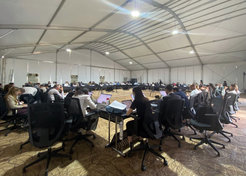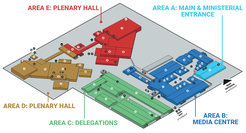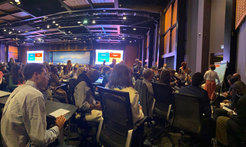Climate Cosmopolitics and Cosmopraxis: Impressions of and at COP27
by Steven Vertovec
Recently at the COP27 United Nations Climate Change Conference in Sharm el-Sheikh, I was overwhelmed with a clash of my own perceptions and emotions wrought through encounters with a complex array of sights, sounds, deep problems and soaring ambitions, frustrations and hopes, power and passion, ideas and innovations, wisdom and bullshit, and the sheer wonder of human variation. I was there as one of the delegates from the Max Planck Society, drawn from across a range of disciplines and institutes to represent the association and to consider ways that it — and German science more broadly — might be better presented and contribute to understanding the nature of climate change, its impacts, mitigation, and potential adaptations. I was also there as an Institute Director and career migration scholar, interacting with other specialists and learning much – indeed more than I anticipated – about the multiple conditions, emerging causes, processes, effects and outcomes, and possible scenarios surrounding migration as it relates to climate change. This experience and learning will shape the future of my own work and my strategies for how our own Max Planck Institute might engage relevant issues productively.

My impressions of and at COP27 begin with observations as an anthropologist who has published a book and several articles on cosmopolitanism. For me, aside from the Kantian philosophical ideals of cosmopolitanism as a universal “citizen of the world” stance, my interest in cosmopolitanism has had more to do with people’s attitudes, orientations and micro-practices that enable the interactional crossing of social boundaries of many kinds: national, cultural, linguistic, religious, gendered, sexual and others. An impressive array of boundary-crossing attitudes and practices were on full display among the reportedly 35,000 people attending the conference from throughout the world. These attitudes and practices were witnessed every morning, for instance, on the free bus service between hotels and the massive conference centre in Sharm el-Sheikh. Against the back drop of Egyptian pop music on the tinny bus speakers, COP delegates, many in some variation of national or ethnic dress, boarded, politely greeted and made space for each other. When arriving in pairs or small groups, they would converse in their own language – resulting overall in a low murmur throughout the bus comprised of a dozen or more languages spoken from row to row. Individually, many engaged strangers in small talk by way of the conference’s universal language of highly accented but thoroughly competent English. This mix of multiple languages, lingua franca, everyday politeness, civility, and cheerful chat was multiplied thousands of times over across the conference venue which provided a wide number of kinds and sites for informal conversation. This is what I consider cosmopraxis, or interactional practices that enable communication across social and cultural differences of many kinds. Whenever I got bored, confused or simply could not understand what was going on at any point during the conference, I was ever pleased to observe such consistent acts of boundary-crossing personal engagement.
Now, of course one shouldn’t be entirely naïve and starry-eyed about the meaning of such instances of cosmopraxis. These small acts of kindness and respect may often certainly conceal positions of unequal power (especially between delegates form the global North and South), patriarchy (based on and expressed variously across the world), prejudice or disdain for others (that politeness only barely covers up), and mischief or bad faith (cosmopraxis can be the tactic of a wolf in sheep’s clothing; with this fact in mind, it is to be noted that some 600 lobbyists of fossil fuel companies were at COP27… persons who have sharp cosmopraxis skills, to be sure, but whose agendas and strategies likely vary radically from the majority of attendees). The fact that English is the lingua franca shows a hegemony not just of language, but historical and contemporary dominance. Nevertheless, and as an admittedly naïve optimist, I observed and still believe that for the majority at the conference, many of these daily practices were underpinned by a genuine will to connect with others as humans sharing a number of values if not goals – something especially intended by so many whose intent in coming to COP27 was expressly to do so with a common, or at least imagined common, agenda of doing something about or in response to climate change.
I wore my anthropologist’s hat, too, while observing negotiations among diplomats. In particular, I witnessed meetings of country representatives seeking to hammer out the WIM/Santiago process for limiting, financing and managing loss and damage from climate change. The sessions I watched were highly technical — one that ran for some two hours was comprised of discussions concerning just eight paragraphs — such that I often frankly lost track of what they were really shaping. In many such meetings, the nomenclature was chock full of terms, abbreviations and acronyms that one must fully know in order to make any sense of the subject at hand. Although I should have expected it of a UN meeting, I was nevertheless rather astounded as the individual negotiators spoke on behalf of entire countries. “The chair recognizes Brazil, followed by China and the EU…”; “thank you, New Zealand… thank you, Zimbabwe….” Moreover, listening to diplomats from well over one hundred countries (interestingly and encouragingly, about half of which were women) was interesting in that their discourse was ever of one standard phrasing if not formula. Even the utterances, of what I gathered to be harsh criticism, was made to sound like agreement, and the responses to criticism sounded like thanks. Of course, well-experienced aficionados will know every sentiment and intention behind such diplomatic language, but as a novice I was fascinated by this truly international discursive game, which offered a kind of exchange across global North and South among a very different set of national political actors and interests, while providing a common standard of behaviour and a forum for the sharing of views. Diplomatic exchange is also formally a kind of cosmopraxis, a set of practices to enable communication and crossing, but a kind not necessarily underpinned by the genuine goodwill I saw on the daily bus on across the conference grounds.

Besides being a card-carrying anthropologist, I have spent considerable time within the realms of Social Geography too. Its approach was useful at the COP27 venue, because different types of activities and categories of people undertook different things in different, designated spaces. The ‘blue zone’ conference area for UN invited delegates was truly extensive, comprising a kind of city in itself (see diagram). (This was opposed to the green zone for general public, which was across a major road away from the main COP27 area.) The blue zone was articulated in different zones of activity and ‘populace’, if not class. After one went through registration and security at the main entrance, there was a large common outdoor area for individuals and groups to meet (and, increasingly, for activists to mount protest), buy an exceedingly overpriced sandwich, and move on to a number of large rooms for ‘side events’, i.e. panels on a range of themes often organized by UN agencies or NGO coalitions. Our Max Planck delegation belonged to RINGO, the combined group of research and independent non-government organizations, which met first thing every morning to discuss activities and flag up daily events of possible interest. The large public area gave way to a conglomeration of several attached buildings housing pavilions set up by individual nations, sets of nations (such as the EU or Nordic countries), agencies (such as FAO, WHO, IPCC), NGOs (like the International Indigenous Peoples Forum on Climate Change. Check) and joint bodies often including corporations (which were sometimes included in national pavilions as well). The variable size of pavilions, which usually included small lecture theaters, conveyed both economic power and an attempt to throw symbolic weight. Some, like the Egyptian or Saudi Arabian pavilion, were five times the size of most countries’ pavilions. Many had wall-sized screens and flashy graphics along with digital display board showing that day’s agenda. Not surprisingly, every pavilion was comprised of materials and displays of all the Good Things that a country or agency is doing to combat climate change. Some merely had photos and art works. It was very hard, of course, to sort the basic truth from the greenwashing — and indeed, it was difficult to tell whether some pavilions were those of NGOs or corporations (the latter being very adept at adopting appropriate lingo and images). Only very few pavilions offered displays with scientific data and analysis, or evidence of actual projects that were addressing climate change issues.

At practically each of the (200 some?) pavilions, every two hours or so there was a public-oriented session on some theme including presentations, panelists and discussion with audiences (see examples). Most often the format was identical despite the nature of the host pavilion: a chairperson managed a set of three or four presentations by speakers, followed by questions and answers from the highly diverse audience. Depending on the theme and host, speakers might include civil servants or politicians, scientists, engineers, bankers, representatives of civil society NGOs, indigenous peoples or – in one very unique case, a farming woman from Niger who was displaced by rapid desertification of her land. These pavilion sessions were, for me, the most satisfying, as speakers talked directly to small gatherings of 20-50 people after which the audience members had the chance to voice their concerns directly to them. Again, the common format across multiple and very different topics also represented a kind of cosmopraxis that offered more exchange than it did to cover up power imbalances between delegates. Not only was there just so much on offer simultaneously, that it was almost impossible to find out what was going on where, but one also felt absolutely dizzy trying to quickly move from one pavilion to another, while trying to navigate rather poorly signposted, packed spaces, inside and between massive buildings within a short space of time. The indoor areas hosting pavilions were open spaces, so most of the time in one pavilion session, one could hear words or applause from a nearby pavilion. Several pavilions offered free coffee from ubiquitous machines pouring espresso, cappuccino and latte macchiato, so the tumult of these areas certainly had an upside.

The entrance, side event and pavilion sites were truly public spaces where activists, agency and national delegates could mingle, network, engage and confront one another. As one moved further into the COP27 event site (from the blue and green buildings to the red and brown ones), this clearly changed. As one colleague and I joked, here one moved into the ‘suit zone’, i.e., from an area of casual dress into a space crowded with people wearing dark suits and immaculate dresses. This was the land of the diplomats, where leaders’ speeches and diplomatic negotiations took place. Depending on who was talking and what they were talking about, observers were permitted in some rooms, allowed to watch by video from other rooms, or excluded altogether. At the very far reaches of this land were the spaces where the national leaders met, again, there were sometimes accessible but more often no-go areas. Moving through or observing people and practices in these spaces, I was amused more than irritated, the two or three times I found myself amidst a human wave being physically (once rather roughly) parted by security agents to let some (usually unrecognizable) politician pass.

While deep in the suit zone, I was very positively impressed by one particular extensive set of sessions concerning the international stocktaking of responses to mitigation – that is, considering how best to prepare societies for the kind of changes they will need to undertake while moving towards low to no carbon economies. I had expected a country-by-country laundry list of policies as the notion of stocktaking would suggest. Instead – at least for the initial two sessions in which I participated – a couple of hundred delegates split into four self-organized groups (on 1. energy, 2. industry, 3. farming, fishing & forestry, and 4. socio-economic dimensions), moving to four corners of the massive hall to share ideas and experiences to brainstorm on what could be learned or advanced form these. The discussions were framed around the notion of ‘just transition’, meaning ways that the changes to society, economy and workforce need to be managed in a way to avoid further inequalities based on income, gender, ethnicity or other social categories. Here, coordinated by a professional facilitator (in my group, from the ILO), national representatives and people of NGOs from around the world spoke eye to eye, movingly calling each other ‘brother’ and ‘sister’ (“I agree fully with my brother from Ghana, that…”, “following the point made by my sister from Columbia…”, etc.). This did not become formulaic, but appeared genuine. Everyone listened attentively and seemed pleased to hear real examples of policies and initiatives. It sounds corny, but I truly felt like part of a global community that gave me hope. While English again functioned as the lingua franca, people were invited to speak their own language and have it translated (none did).

Undoubtedly the most impressive discussion I witnessed, however, was a side event on human rights and climate justice, comprised of a panel including the Secretary General of Amnesty International alongside key representatives of Greenpeace, the fantastic Rise Up movement leader Vanessa Nakate, and speakers for the Vanuatu ICJ Initiative to submit a resolution before the United Nations General Assembly and the International Court of Justice to place human rights at the centre of climate change decision-making. The speakers were very articulate, passionate and powerful. I felt it was a shame that this was a side event only experienced by only a couple of hundred people. The reasoning and strength of the call made here were highly compelling.
Besides the sheer scale of the event and number of happenings, the disjuncture between the discourse and activities across the different scenes and sites at COP27 (and, I gather, at all COP conferences) is likely my greatest take-away impression of the event. While the general public around the world usually only hears about the major international negotiations – not least their limited progress and often dismal failure – the mind-blowing number and range of other things happening simultaneously at COP – that were very often far more positive and encouraging than the international negotiations – is rarely described.
Such a myriad array of activities across vastly different levels and kinds of discussion were seemingly joined, on the surface, by a common cosmopolitics. Drawing on work by Isabelle Stengers, Bruno Latour, Pheng Cheah and others, I consider the notion of cosmopolitics to refer to attempts to overcome – though debates, activities and decision-making – the limitations of national politics for the purpose of shaping transnational political cooperation and addressing a global agenda. One could say that this is certainly a kind of broad ideal in the realm of diplomacy at COP gatherings, but it is one that usually loses seriously to national interests. Scientific, NGO and activist practices are far more successful cosmopolitical endeavors by way of networks and discourses that do not consider the national as pre-eminent or essential (but rather, often, an obstacle).
Essential to cosmopolitical goals, I would say, are modes of cosmopraxis. Especially when considering mutual acts of cosmopraxis, I am inspired that so many thousands came to Egypt (the problematic irony of contributing extensively to a massive carbon footprint aside) and engaged one another sincerely through feelings of interconnectivity, common belonging, common threat, and common future. I do not bemoan any homogenizing or hegemonic tendencies: they are certainly present if not unavoidable. Despite these, the delegates seem to honestly respect if not prize features of cultural and linguistic difference.
Myriad sets of alternative visions of climate change, its mitigation and adaptation are surely to be expected. The disjuncture between the levels and kinds of discussion at COP is perhaps unavoidable, but my hope lies in a more joined up cosmopolitics. And this, of course, must mean more than joining up slogans but rather joining up of understandings and strategies.

















